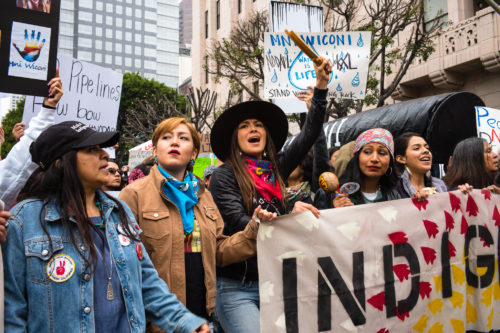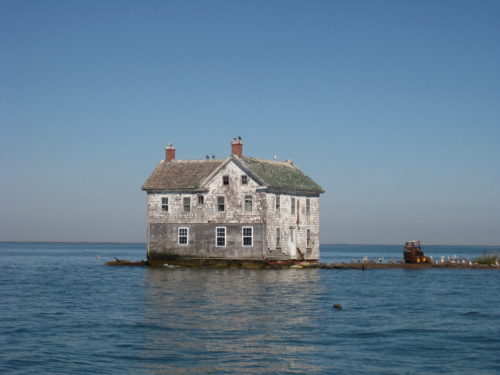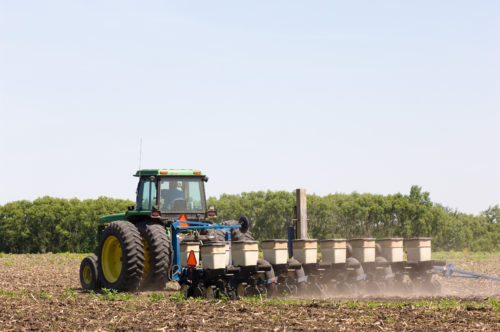A Differential Quilt Analysis: How can everyone stay warm this winter?
Andrea Miralles-Barboza ·This week in our Environment and Society class, we had the chance to discuss the relationship of humans and the environment with environmental anthropologist Dr. Christy Miller Hesed and political scientist Dr. Isabella Alcañiz. Although these women come from different disciplines, they share (like most of my classmates) a common interest in environmental and climactic justice, or the idea that the environment and how we interact with it has deep connections to social inequality. More specifically, they acknowledge that some groups of people receive a disproportionate share of environmental impacts, and their research investigates how climate change will make these social-environmental issues worse.

“San Jose Museum of Quilts & Textiles” by Bill Volckening from Wikimedia Commons is licensed under CC BY-SA 4.0.
To me, this connection between the environment and social equality can best be pictured like a quilt. For each group we want to examine, this quilt will combine that specific group’s historical, social, economic, environmental, and political patches, all which reinforce one another to form a very complicated and multilayered textile. For some people who have historically favorable social conditions, such as being wealthy and white, their social and environmental conditions will make it so that their quilt is more suitable for cold weather and will keep them warm throughout the winter. On the other hand, for groups that society has oppressed, taken advantage of, and neglected all-together, their quilt will not do the same job.
In doing a “differential quilt analysis,” we find that this difference in the protection each quilt gives us reflects how groups with different backgrounds get protected from and subjected to environmental and climactic issues. Some people rarely have to think of environmental issues in their day-to-day lives, while others face these issues on a daily basis. This is the quilt of Environmental Justice, also known as EJ.
So, what can we do to make sure everyone is warm during the winter? This is where Christy, Isabella, and my classmates have some ideas. In class, Dr. Christy Miller Hesed discussed the history of the EJ movement, which began in 1982 and has roots in Warren County, NC. In Warren County, African American communities were the target for landfill sites containing highly toxic chemicals such as PCBs. This event led to massive pushback from the community and public attention was brought to the issue of uneven distribution of environmental harms such as waste sites. During this discussion, our classmate Faith made an observation that although issues of environmental justice have been well-recorded in the United States since the civil rights movement, it is interesting that the case of Warren County is designated the official starting point of the Environmental Justice movement. The EJ movement has evolved to include many races, genders, and marginalized groups in a fight not just for equality, but for equity.

The difference between equality and equity is a key concept that we discussed in our class, which I think is best shown in the image above. To put it in the context of environmental justice, African American communities who face issues such as siting toxic landfills in their communities should not just have standard environmental solutions thrown at them along with the rest of society. Instead, they should be given additional resources as they are already at a social disadvantage.

One good example of an EJ issue is mentioned in Christy's paper “Promoting climate justice in high-income countries: lessons from African American communities on the Chesapeake Bay,” in which African American communities have been historically forced to live on land that is especially prone to flooding. In this case, we see communities that have faced systemic oppression being further exposed to issues related to climate change, such as sea level rise. This paper highlights the importance of procedural justice, or inclusion of all stakeholders in all parts of a decision-making process. For EJ to exist, stakeholder engagement is key in order to get the perspective of the most impacted groups.1
During the second part of our class, Dr. Isabella Alcañiz, a political scientist whose area of focus is Comparative Politics, spoke about the discipline of Political Science (PS) and how it contributes to our understanding of humans and the environment. She also focused on the idea of social inequality brought up during our discussion on EJ, and shared some interesting papers for us to read about the topic.
Political Science as a whole is a discipline that is well-established with a lot of data on power structures and social organization, but until recently has lacked participation in climate change studies. This shift is due to the urgency of environmental issues today, such as climate change, and has resulted in PS playing a game of catch-up. This is not a problem for the discipline though, as it already has resources in the forms of theory and data to study humans and the environment and how climate change & inequality relate to these topics.
During class discussions we kept coming back to the idea that PS needs “salient” issues to research and analyze. This essentially means that because the impacts of climate change are oftentimes felt much later than the contributions to climate change themselves are made, only now is the discipline really starting to get serious about this issue. Dr. Alcañiz’s paper, titled “How does Political Science Tackle Social Inequality and Climate Change?” speaks to the potential for contributions to climate change studies from her field, specifically how the subfield of American Politics has made significant contributions to studying Environmental Justice.2
Her second paper, titled “Between the Global Commodity Boom and Subnational State Capacities: Payment for Environmental Services to Fight Deforestation in Argentina,” looks at how effectively a government’s cash-transfer program could curb high levels of deforestation in Argentina for soybean and grain crops.3

Argentina is an especially interesting case because of how highly impacted the landscape of Latin America is as a result of our increasingly consumptive lifestyle, and because many forests in question include indigenous communities whose land is not necessarily valued as much as its agriculturally-productive counterparts. This case also poses the question: how can we make these short-term programs create long-term habits for protecting people and the environment? Overall, this study found that these kinds of programs were effective at reducing deforestation and highlighted the importance of a well-funded and high-functioning local government to address issues of the environment. In this case, PS shows us that access to resources and social equality are important in addressing environmental issues.
So, let’s come back to this idea of the quilt: If each of us is the sum of all of our parts, we cannot just change the patches of our quilts to address larger-scale socio-environmental problems, such as environmental justice. If we cannot do this, what can we, as individuals or as a society, do to make sure that all groups can be equally protected from the cold?
Several potential approaches come to mind. Can I give part of my quilt to my neighbor? Can we all push for our neighbors to get the supplemental tools that are needed to protect them from the cold, such as some extra sheets and blankets or perhaps a stove or a heater? Can we observe how the quilt is physically constructed and, through power structures, change the way we put the quilt together? How can we make sure a plan for quilts accounts for long-term protection from the cold? Finally, and most importantly, how can we get people who are warm enough to care about people who are not?
I am not entirely sure how we answer these complex problems, but I do know that they will not be solved by a singular discipline, and also that any true success needs to be achieved through the inclusion of highly impacted groups.
How would you propose we
make sure everyone can be warm this winter?

References:
1. Hesed, C. D. M., & Ostergren, D. M. (2017). Promoting climate justice in high-income countries: lessons from African American communities on the Chesapeake Bay. Climatic change, 143( 1-2), 185- 200.
2. Alcañiz, I., & Pearson M. M., (N.D.). How does Political Science Tackle Social Inequality and Climate Change?
3. Alcañiz, I., & Gutierrez (N.D.) Between the Global Commodity Boom and Subnational State Capacities: Payment for Environmental Services to Fight Deforestation in Argentina.
About the author
Andrea Miralles-Barboza

Andrea Miralles-Barboza is a second year master’s student in the University of Maryland’s Marine Estuarine Environmental Sciences program, with a concentration in Environment and Society. She works with Dr. Michael Paolisso to contextualize the coastal climate adaptation of managed retreat to the Lower Eastern Shore. Andrea is also a member of a research team supported by the Maryland Department of Natural Resources that is examining the human dimensions of a marsh restoration technique known as Thin-Layer Placement, a beneficial use of sediment to restore degraded marshland occurring in the same area of the Chesapeake Bay.
Next Post > Eyes on the prize: Looking beyond graduate school during the 2019 MEES Colloquium
Comments
-
Taylor Gedeon 6 years ago
I think the “differential quilt analysis" should be your thesis topic! Run with it!
-
Faith Taylor 6 years ago
I really liked the way that you continuously brought you essay back to the central idea of the quilt
-
Isabella Alcañiz 6 years ago
I enjoyed reading such a thoughtful essay, using such an original take. I really liked the metaphor (or analogy) of the quilt.
-
Michael J. Paolisso 6 years ago
Very thoughtful blog. The quilt analogy made me think of early 20th century anthropology when conceptually we thought of culture as a "thing of shreds and patches," just like a quilt. Each societies quilt is different depending on historical and contemporary factors. We later dropped this approach and developed different theories to explain culture and its diffusion. I think you parallel this when you ask how are different patches related and what drives the aggregate pattern. The quilt analogy works well, and provides a springboard for an inclusive discussion among diverse stakeholders. Well done!
-
Amanda Rockler 6 years ago
Love the quilt analogy and those are some big questions you posed at the end. Lot's of opportunity for future research.
-
Isabel Sullivan 6 years ago
The interconnections of the quilt idea are awesome! I also like how you brought in that we are part of a whole! Great post!
-
Alison Thieme 6 years ago
I like that you bring up the issue of trying to tackle long term issues with short term solutions, choosing solutions that match the scale of the problem is an ongoing challenge.
I spent last weekend in Lancaster County, PA looking at quilts. Using quilts as a link to these ideas is really evocative.
-
Hamani Wilson 6 years ago
"I am not entirely sure how we answer these complex problems, but I do know that they will not be solved by a singular discipline, and also that any true success needs to be achieved through the inclusion of highly impacted groups."
I really appreciated this quote, the multifaceted and interdisciplinary disciplines will also allow us to hold our scientific analysis accountable.
-
Kayle Krieg 6 years ago
Great blog! The house that sunk into the Chesapeake at Holland Island is very interesting, and I had never heard of it before. What a powerful image. I really enjoyed the quilt analogy, and what a great job weaving it through the entire post.
-
Enid Munoz Ruiz 6 years ago
Nice job! The quilt analogy is marvelous. As someone who currently resides in one of these flood-prone communities I agree stakeholders need to lessen the injustice present in these locations.